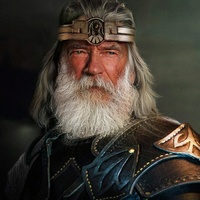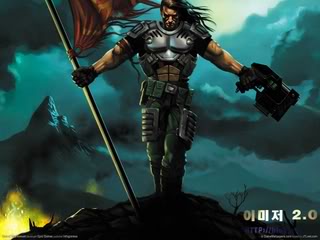|
| | A complete history of videogames - (volume 2) |  |
| | | Author | Message |
|---|
Flaming Turd
Vanir

Number of posts : 4225
Registration date : 2007-08-28
 |  Subject: A complete history of videogames - (volume 2) Subject: A complete history of videogames - (volume 2)  Mon 26 Nov - 20:24 Mon 26 Nov - 20:24 | |
| 19881. Barbarian 2 (the dungeon of Drax) aka Axe of rage(1) We got this “gladiator crown” that Schwarzenegger wears. It is depicted in the comic adaptation as a metallic protector for the nose.  But in the movie the use is not so clear, as it is not long enough to cover the nose. It is probably a protector for hits in the head, maybe it could be also used as a weapon with a strong header.  And maybe it also is a symbol of the slavery status of the warrior. When the owner of Conan sets him free, symbolically removes the crown from his head.  There’s another version of the crown, which is clearly a nasal protector. This version belongs maybe to a deleted scene.  The crown was stupidily used in the movie “The Destroyer” with that another barbarian that is not the same character at all, but was “played” by the same actor. Why? Only for esthetical reason, probably. Because there’s no reason why he would wear it now being free. Does he a have nostalgic motivation which made him buy a slave crown and wear it in his travels? Not the best protection for the head, a nice helmet would have been better… And it’s obvious this “Destroyer” man is not too worried about armouring himself. Anyway, the only true reason I can find is that in the original script of Roy Thomas, Conan is described as fighting as a gladiator for money, besides being a thief.  But the pathethic truth is that the crown appeared in that movie to be somehow related to the Milius one, and make us believe it is a sequel. Which was fucking not. The apparence of the character in the cover of the videogame “Barbarian Two” is clearly an imitation of Schwarzenegger in “The Destroyer”.    Notice up and right, in this next pic, the portrait of Gorth with the “pitfighter crown”. Is “Gorth the barbarian” a gladiator? Maybe in the first game, where it consisted in a tournament of “one vs one” which also included a pit… But there was no “gladiator crown” then. And now, the barbarian is not in a pit fight anymore, but travelling through different landscapes and killing each prehistorical motherfucking creature he founds on his way. So, same use for this crown as in “The Destroyer”: empty esthetical reason.  The crown is heavily modified there.  So, yes, Maria Whittaker is here again. Isn’t that a good new? Now you can choose her as a character, and let me tell you the princess Mariana is not below the barbarian Gorth in massacring skills… Sadly, she’s a so unattractive woman…  (2) (2) Mariana has a modified versión of the atlantean sword.   As you know, the langets run down the blade from the hilt creating a ricasso, or a place the blade could safely grabbed to maneuver in close quarter fighting.    (3) (3) Another modified version of the atlantean weapon can be found. Although is partially occulted by the words, the langets runnig down the blade creating the ricasso are visible.   And again the same weapon. That sword on the shield is a compass, marking the way the character must follow in order to find the exits.   (4) (4) Princess Mariana is “en garde” in the “Hasso No Kamae” Japanese kendo style. It's interesting to be found in the woman, and not in the male character.    But even though it's a typical pose related to male swordfighters, Valeria was not the only female warrior who used it. Later, Brigitte Nielsen would also adopt this guard position in that movie called in Spain “The Red Warrior”. As you know also teached by the sword master Kiyoshi Yamazaki in the same fighting style the Milius’ movie had. (And same as in “Conan the barbarian”, he appeared as a kenjutsu teacher character in this film).   End of direct Milius' movie references. This is the intro for the game, a short of “Nemedian chronicles” also used as you know in the movies with The Wizard as the narrator.  This alternate cover features a Charles Manson redneck. Look, he’s crying, poor Charles. And, hey, it includes a tattoo!  The back cover has the epical story of "Barbarian 2". You realize this is only a game for crazy teenager punks, and nothing more. It’s healthy not to take ultraviolence too seriously. I like the story even if it's dumb and maybe that's the first reason why I like it.    I know I’m not the only one who is thinking shit about this next pic.  Chopped Neanderthal.   "Trolls!" muttered Subotai, his eyes widening. "The legends of my people tell of them." Valeria shook her head. "No, they we the descendents of an ancient race, who dwelt in caves from times beyond man's memory." "How could they thus have sunk to the level of beasts?" muttered the small Hyrkanian. Valeria said: "From what I have heard, such is not the case. They are not men who have become animals, but animals who have almost grown to men. My people say that long, long ago there were two branches of man: our forebears and these shadow-dwellers. My ancestors called them that because these beast-men could not endure the light of day and chose to make their home in the hollows beneath the earth. When our forebears spread out across the land, seeking the daylight and the fertile earth, these shadow-dwellers burrowed ever deeper into the ground." "And fed on human flesh," added Subotai disgustedly.   The Neanderthal Man was a species of human that habited Europe and some parts of the west of Asia from 230.000 to 29.000 years back, during the middle of the Paleolithic. Very well adapted to extreme cold temperatures, with wide skulls, strong and tough complexion and big noses, physical evidences shared with actual Artic people. Their brains where same size or even bigger than the modern man has. A neanderthal would size about 1’65 meters and had a heavy skeleton and strong musculature. Cannibalism was something probed as a fact, in different neanderthal sites. The bone remains show cut marks made with stone tools, and they are very well conserved by having been removed all the flesh from them. It was not an anthropophagian cannibalism, as it is believed, not for food but for part of the burial rituals. But in some other cases, because of lacking of real food, cannibalism could have been practiced with alimentary objectives.  Some times, they have been considered a subspecies of the Homo sapiens (Homo sapiens neanderthalensis), but in today’s consensus it’s considered a separated species (Homo neanderthalensis). Genetic studies concluded that the Neanderthal Man is not an ancestor of the Modern Man, but cousins with ancient shared ancestors. Even though, some more recent studies argue that modern man owns neanderthal genes, so the mix between species could have happened. Neanderthals and modern Homo sapiens coexisted in western Europe for at least 10.000 years The causes of the extinction of the Neanderthal are still a mystery. Did the homo sapiens compited with them for the natural recourses? Did they killed and exterminated them in combat? It’s hard to believe a war for recourses could happened in a time where so few humans lived in the earth, but who knows.  Interesting is the idea that says the memory of the Neanderthals, is inside our collective unconscious as the image of ogres, trolls and some other mythological creatures. It’s curious how these creatures are always depicted as hairy, strong and habitants of the deep forest, and how the heroes exterminated them. In the “País Vasco”, (north of Spain) there’s the legend of the “Basajaun”, which means the “Lord of the Forest” or “Wild Lord” in euskera, an anthropomorphic creature who lives in the deepest part of forests or caves, with dense and long hair, big and strong body. They say that the first men who arrived to that land founded him and he touched them the secrets of metallurgy.  (But, hey, c’mon, Neanderthals teaching the “Secret of Steel” to homo sapiens? Sure. And Mickey Mouse teached them how to build nuclear weapons, too… Wait, that second thing is true). Same way as the Neanderthals are described in the Milius’ movie scripts, they are often called “ape-man” or “beast-man”. It is because of the actual symbolism that in popular culture has the image of the Neanderthal as a brute hairy retard which was not. They are only ape-like if we compare them with ourselves. Behind our parameters and egocentric point of view, they could look like animals but that is nothing but blindness and the oblivion of our own animal origin. The Neanderthals are often classified, too, as “subhuman”, which is an even worse and more serious mistake. The Milius’ version of the Neanderthals has something of Lovecraftian, first in the vision of Subotai who, disgusted by their appareance, believes they are men involutioned into animals. Races expulsed from light and forced to hide in caverns, adapted to darkness and therefore deformed, which turn them into inferior. The idea of involution –changes of the bodies into a more primitive estate in order to be better adapted to the characteristics of the environments- can’t be classified as inferior. Primitive organisms are tougher and stronger than too specialized –evolutioned creatures-. A foetus is perfectly adapted to its environment, meanwhile us mature humans, more “evolutioned” can’t survive inside a womb. But in the Lovecraftian philosophy, and in Howardian too –by extention in the thoughts of that time- involution was considered a repugnant change and was even used as the explanation of the existence of the different ethnic groups by racist ideologies. Any one who knows Lovecraft knows he -extreme subjectively- considered lower and even unnatural any creature which aesthetically could be considered “ugly” in classical parameters –that is, for those who have read Nietzsche, “non Apolinean”. That idea as the german philosopher said, is essentially wrong. It’s a mistake that probably comes from a misconception of the theory of evolucion, which would claim that the creatures are trying to reach an objective through the changes, that is, become perfect, so therefore each anterior stage would be considerer less perfect. That is so wrong.  The explanation of the nature of the Neanderthals made by Valeria is more close to a true historical and realistic atmosphere as Milius was looking for the film, giving them a separated origin from ourselves, and playing with the idea of the Neanderthals not being extincted, but having survived inside the caverns and holes of the earth, meanwhile the homo sapiens discovered how to cultivate the earth and build metal tools. A myth related with the “País Vasco” one, and with the legends of the “Little people” from England, Scotland and Ireland, once depicted as beautiful fairies and turned into monsters after the arrival of chistianism.    Don't go breaking my Heart.  Vagina Dentata is always hungry.   "I am the wellspring from which you flow". 
Last edited by on Sat 8 Dec - 5:25; edited 3 times in total | |
|   | | Flaming Turd
Vanir

Number of posts : 4225
Registration date : 2007-08-28
 |  Subject: Re: A complete history of videogames - (volume 2) Subject: Re: A complete history of videogames - (volume 2)  Mon 26 Nov - 20:26 Mon 26 Nov - 20:26 | |
| 2. Galdregon’s Domain aka Death BringerAzazael, known once as “The DeathBringer”, has started the searching for 5 gems which will give him power to become the ruler of the world. Fearing his royal ass would be in trouble, King Rohan sends a mercenary barbarian warrior to find the 5 gems before the necromotherfucker does. The problem is they are hidden somewhere among 2500 locations. And what does it sound like, to you? Do you think I enjoyed this game? C’mon, you are clever asses. Yeah, this is boring like boredom itself. (1) This is Schwarzenegger not from the Milius’ movie at all, but as a character heavily influenced by Milius’ one as both warriors even share the same name. Yeah, it’s from “The Destroyer” characterization, but anyway The Governator as a barbarian will always be a Milius’ movie relation. Also he is supposed to hold the Atlantean Sword, which the one from the videogame cover would be an altered version. In the end this new sword it’s not too faithful to the original as even the ricasso has been removed. Therefore the blade can’t be hold so both hands are on the grip. Any other adornments of the original warrior that could have been linked with the Milius’ movie, like the “gladiator crown” or the golden “wheel of pain” pendant, have also been omitted. Still, he is using the famous "hasso no kamae" japanese kendo guard.    (1) (1) Even though the Cult of Set concept is not just limited to the “Conan the barbarian” movie, I think that I’m not wrong if I assume the direct inspiration was the Milius’ movie rather than any other font.   The Temple of Set in the map is up, at right. Looks like a greek parthenon.   (From the game instructions): “THE TEMPLE OF SET - Here the followers of the snake god worship. They are all evil and those who do not follow their cult are sacrificed. Many peasants have been taken for their foul rites. The high priestess of Set is known to be able to change into a demon form at will to devour her enemies”. Doesn’t it all sound familiar?  In the movie, Thulsa Doom is more probably a man who is able to transform himself into an animal –his nagual, the animal he worships therefore his benefactor-, because he has learned how to dream himself in a different form than that of a human being. This way he can escape from a possible attack. This Milius version of a sorcerer is more close to a “realistic” version of ancient shamans. In the novelization, by change, Doom is more probably an humanoid snake who takes the shape of a human to deceive his followers and create a religion. Conan uses the “Eye of Set” to reveal his natural face and shows the truth to the Children of Doom. De Camp and Lin Carter as authors of the novelization sure took the original literary concept from Bob Howard who created the serpent people as the natural foes of the whole humankind since pre-atlantean times. Intelligent evolutioned reptiles, their fake human apparence could be dissolved with some secret words. The character of Tulsa Doom also came from those original literary Howard's "King Kull" stories, and although undead was a human being necromancer in origin. Anyway he also had the capacity of changing his physical apparence and was also closely related with the serpent people and a worshipper of the Great Serpent. "The Snake people infiltrated human society and ruled from behind the scenes for a time but were again discovered, defeated and cast out in a secret war. However, they later repeated this tactic but added the front of a Snake Cult religion, which gained power and influence within Valusia while they also used their abilities of disguise to murder and replace each reigning monarch".  This concept of the disguised snakes is related to some modern conspiracy theories and nightmares.  In the game, the guards looks like they belong to those snake-people preatlantean race, without any disguise.   The image of Milius about the Cult is probably connected with the criticism of the phylosopher Nietzsche to religions. He said the humans are so afraid of the desires and impulses of the will that they are allways trying to find comfort and control over them, better than follow the direction it marks. As a result, they renunce to them, becoming empty and therefore dead. Because desire and passion is what gives life a sense. So, as it is impossible to deny will, they only deny their own, and then go looking for the will of some other to follow blindly as the real truth. ("Thy Will be done, on earth as it is in Heaven"). That's why for Nietzsche the religion is the essence of slavery. He also says that the true reason people gets attracted to the ideas of religion -the believing in sobrenatural- is just resentment, a not feeling comfortable with life, not accepting the tragical nature of existence. Seeing the desire of following a religion as a escape from reality, and considering Milius fascist tendencies it's not so strange Milius took the idea of Hippies as the ones who where attracted to Doom's will, a common concept from right politicies consider hippism equal to "junkie". But it is more probably their idea of "love" what Milius feel rejected of, as he could see them as naive and immature poor souls who needed to believe in fairy tales better than accepting the tragedy of existence. Anyway I personally think that it's a prejudge and a deep misunderstand of what hippism really was, as a result of how misunderstood and prejudged the military soldiers felt about the hippie movement during the sixties.  But it would be better to know what Milius would exactly wanted to say as he is no doubt a very intelligent man with very personal and deep points of view, so would be a true prejudge if I said "he wanted to say that" and putting words of mine in his mouth. If we go a little more deep, we will see that the "morality of love" was also denied by Nietzsche, who said that obedience, sacrifice, compassion were vulgar, a moral of slaves, the morale of resentment against everything high, noble, unique and outstanding, and was "the destruction of the ancient world values". It just sounds too irractional and brutal at the first time but beyond that first impression there's some more meanings, same as happens with the Milius' scripts. It's important to notice that primitive christianism and the figure of Jesuschrist was deeple admired by Nietzsche, as he saw him as an anarchist and a fighter for the right of not having any other will than the personal one. What he hated was the disfiguration of the original concepts and words, as he was not against "love" or "compassion" but against what those words had ended meaning: submission, manipulation, another form of slavery. The subversive style is just a way of breaking through shields of old fashioned morality, but the purpose is not other than destroying anything that is not true. In the end if you want to become stronger, it's always better an ugly truth than a beautiful lie. Because lies are Doom. Truth, no matter how painful, is Life. In an even more close to the Milius' movie relation, when you find an acolytes or priests of Set, they try again and again to suck your will. They tell you things like: “Welcome, my son”. “Set is Life”. “Lay down your sword and return to Set”.   HA! Time enough for Set… in the grave! This is not a concrete and direct Milius’ movie relation, but the King who hires the barbarian in the game, is called the same as the “King Osric, The Usurper”. Anyway it’s not impossible that the movie could have been the inspiration. “Granted an audience with the King, you are ushered into the main hall. King Rohan, The Usurper, sits among his courtiers, he looks greatly troubled. He orders you to be seated then recounts his story. He tells you that the high priests of Shool, the diabolic sect of the accursed, have once more resurrected the long dead arcane wizard, Azazael”.       These mighty green knights won’t let you pass through their forest. And it’s better you don’t try to fight against them because they will say “NI” until you die. Or you can always bring them shrubbery. It must be a good one and not too expensive.  
Last edited by on Mon 18 Feb - 23:23; edited 1 time in total | |
|   | | Flaming Turd
Vanir

Number of posts : 4225
Registration date : 2007-08-28
 |  Subject: Re: A complete history of videogames - (volume 2) Subject: Re: A complete history of videogames - (volume 2)  Mon 26 Nov - 20:26 Mon 26 Nov - 20:26 | |
| 3. Sword of Sodan(1) We have this title design, with golden metallic letters and a sword behind them. It’s not an exact replica of the “Conan the barbarian” logo as happened with Rastan, but still the inspiration is clear.   Notice the zombie with jeans.   Here the sword is even crossing through the letters, like in the Milius’ movie logo.  (2) (2) Apparently we have the “gladiator crown” one more time. And again this man is not a gladiator, not a slave. He is the son of a killed king who comes through tons of enemies’ guts to reconquest his stoled legitime throne in some kinda “Lion King” precursor bullshit. Anyway, what is important is that we have the “pitfighter crown”. Apparently.     Valeria wears one too, in the concept drawings for the pitfighting deleted scenes.  (3) (3) We have this guard position –in the sega genesis-megadrive version only-. It’s featured in the Milius’ movie, but is not one of the most used by the character there. It’s a position of “en garde” and also a preparation for a pricking attack.    As we all know because we watch movies untill the credit titles ends, Kiyoshi Yamazaki was the sword master of the movie of Milius, but also was instructor in the movies “The Destroyer” and “Red Sonja” so the fighting style is essentially the same. The guard position we are into is used often in these next movies.    And it is the characteristic “en garde” posture for Nielsen -as the “Hasso no Kamae” posture we all know is closely related to Schwarzenegger-.  This is not a direct Milius’ movie relation, because this scene was deleted from the final cut of the movie so couldn’t have been available as a reference but the posture of the game shares the same japanese fencing style the movie has. It is also interesting as an example of the way “barbarian” characters using oriental fencing techniques. The purpose of hiding the sword is to prevent your opponent to be aware of the length of your sword. It is obviously an invitation or inducement to one's opponent to attack first. Not showing your strength or weapon to your adversary, you can react as your wish.  Originally the basic objective in Iaido (the other Japanese fencing art) was to cut the adversary and beat it as soon as possible, taking the initiative even by surprise if possible, without letting any opportunity to defend himself exploiting the carelessness, distraction or lack of vigilance on the other. The Samurai was obliged to stay alert every moment of their lives, because the opponent was in his perfect right to take a careless or distraction to attack. It was considered an honor to have been the first to attack and kill the enemy by surprise. No it was not unworthy, or ignoble shame take the initiative to attack without warning its enemy, but rather an used and common rule known and accepted by all. But even if the other was alert and on guard, the fact of being the first to attack had great importance. Now watch Subotai in this “en garde” position with his blade hidden behind his arm.  This is the one and only song of the game. Not related at all with the Millius' movie, anyway has an ancient quality that makes it interesting. http://www.conancompletist.com/dwl/sword_of_sodan.mp3  This game had a lot of gore and violence, corpses lie driven before you with their chests opened, and you can even decapitate some defeated enemies. “Revenge is best written in blood”, said the promo. But beyond that always welcome ultraviolence for children I found it boring and the gameplay is just disgusting. Here again you choose being a male or a female.   You fuck with me, you're fucking with the best.   At one point, you will find “The Kurgans”, ancient European iron age warriors.    “The Kurgan” is a character from the movie “Highlander” (1986), portrayed by actor Clancy Brown. The Kurgan's true name is never stated. His tribe, the Kurgans, were infamous for their cruelty, and were known to "toss children into pits full of starved dogs, and watch them fight [for the] meat" for amusement.   The director of "Highlander", Russel Mulcahy had Arnold Schwarzenegger in mind, as the actor who would play The Kurgan. It's not too hard to imagine from which movie he would take that idea.  As a matter of fact, The Kurgan is in some parts of the movie using his sword in a way it very much reminds Arnold in the Milius' movie –specially in the scene where he is training with his sword, making katas-, so the direct and first inspiration is even more obvious.   Kurgan means "Mound builder". The Encylopaedia Britannica describes the Kurgan culture as follows: "seminomadic pastoralist culture that spread from the Russian steppes to Danubian Europe c. 3500 B.C. By c 2300 B.C. the Kurgans arrived in the Aegean and Adriatic regions. The Kurgans buried their dead in deep shafts within artificial burial mounds or barrows. The name means 'barrow' or 'artificial mound' in Turkic and Russian." Some more recent sources date Kurgans to 5000 BC.  It's interesting to notice the Kurgan culture (Yamnaya or Pit-Grave culture) could probably have originated the Celts who became the root of most of the culture of Western Europe. Just where in that vast area they lived is not known. The Kurgan people extended from the European plain to the steppes of Central Asia. Undoubtedly they are the origin of at least the later Indoeuropean migrants, the Persians, Indics, Greeks, Celts, Germanics and Slavs. It may be that earlier Indoeuropean peoples who left the steppes and were known in ancient times, such as the Hittites and Hurrians, represented a pre-Kurgan or very early Kurgan phase. This is not known. There is still argument over the place of origin of the Indoeuropeans. Most argue for either the steppes northeast of the Black Sea, the northern Caucasus, or eastern Anatolia. Some believes they are from the steppes NE of the Black Sea. It is on the steppes that the Kurgan culture developed. In the movie The Kurgan, as an Immortal, could only be killed by decapitation. In the game, it’s the same. If you don’t cut his head as he is defeated in his knees he will recover and kick your ass until you die because there can be only one.       One of the enemies is a modern day –but fucking old in age- Motörhead fan. Why? Dunno. Maybe because there’s a connection between heavy metal and barbarians? Maybe because the game designers where drunk? Maybe I don’t give a shit?  The usurper Necromancer Zoras shares a hobby with Vlad Tepes. Impalation is a constant danger in this castle.  This monster head sculpture, which also throws fire though its mouth, could be related to the one that appeared in “The Destroyer” movie which kept inside its mouth the Horn of Dagoth. That is not connected with the Milius' movie in any way, but It's interesting to notice as a possible cinematographic influence from a movie that was very influenced by the Milius' one. Conan the Destroyer - 1983 Concept art and design (With Pierluigi Basile as mentor, Stout & Basile production designed the film)      “My son”… “My son”…  “My son? MY ASS!”    Swords used like "lightning conductors" as a symbol of triumph are not unknown to the movie. First of all since the Frazetta painting "Against the Gods", direct unconfessed inspiration for the Casaro's poster. It is, probably, a metaphor of the union of the earth and the sky, being the man who holds the sword the conection, receiver and keeper of both powers.   
Last edited by Flaming Turd on Thu 5 Jun - 17:53; edited 2 times in total | |
|   | | Flaming Turd
Vanir

Number of posts : 4225
Registration date : 2007-08-28
 |  Subject: Re: A complete history of videogames - (volume 2) Subject: Re: A complete history of videogames - (volume 2)  Mon 26 Nov - 20:28 Mon 26 Nov - 20:28 | |
| 19891. Genghis Khan “A man's greatest work is to break his enemies, to drive them before him, to take from them all the things that have been theirs, to hear the weeping of those who cherished them, to take their horses between his knees and to press in his arms the most desirable of their women”. (Genghis Khan in response to a friend claiming that best in life was "A fine hawk on the wrist, a clear day, and a fast horse upon which to ride").  There are no concrete relation with the Milius’ movie in this videogame. But someheow I feel that those games placed in historical ancient ages are more faithful to the Millius' movie than a lot of "barbarians" and "sword and sorcery" videogames. There's more of realistic historical ambientation in the movie than fantasy. It’s a fact that John Milius had Genghis Khan in mind as an inspiration for the movie. Even more, besides Conan recites a text from the same Genghis Khan -which would be by its own a nice reason to include the game in this list- to a other “metaphorical” Khan in person, he is not much later chased by dogs in a very probably allusion to the instinctive fear Genghis Khan had for those animals. How much did the ancient Mongols inspired the Milius’ movie? Enough to almost consider it a historical Mongols film.  “Genghis Khan” means in mongol “the emperor of every men”. Was born in 1162 with the original name of Temüjin which means “the best steel”. Belonged to the Borjigin clan, an aristocratic family, but still was not too powerful as the Mongols weren’t the strongest cultures of the steppe yet. But the situation of the clan was drastically changed and suddenly Temüjin and his family were forced to live in the poverty. Some interesting facts of that time probe the survival strength of the child like having no horses to practice horse riding arts, he rode wild goats. Even though he ended becoming an excellent horseman and surprised every one also with his archer abilities. In this tough situation Temüjin soon started to attract friends of his same age, who became very loyal to him. That’s the origin of his future imperial guard. The most important friend of that time was a high class young called Jamuka, who become his “sweared brother”. The charism of Temüjin also attracted the attention of an old friend of his father, Toghril, Jan of the Keraitas, who named him a second class chief. Jealous by the fast rising power of Temüjin, his “sweared brother” stopped supporting him and became an enemy. The Keraitas helped China to subdue the Tartars. They won, therefore Toghril and Temüjin got more power. Soon they both also entered in conflict and Temüjin was victorious. More and more clans felt attracted to the rising power of Temüjin and declared their loyalty to him. That way, the Keraitas disappeared and the only clan which could compete with the future Khan were the Naimanos, with whom Jamuka and his followers were refugee. The Naimanos were soon beated and subdued, and Jamuka, once “sweared brother” of Temüjin, was captured and executed. A clan who helped the Naimanos, the Merkita, were defeated by Sübedei (Subotai), member of the personal guard of Temüjin and a character who will become the most brilliant commander at the service of the Khan. In 1206 he gets the title of khaqan and takes the name of Gengis Kan. Then he started the true expansion of Mongolia. As a culture made of independent clans joined by military forces, there was necessary to find a common enemy in order to maintain that unity so the barbarian hordes pointed at China. The Khan was very meticulous before attacking a more advanced culture, and he tried to get as much information as he could about them from merchants. He practiced psychological war and used terror as a weapon, commiting atrocious slaughters and showing the results in order to make their enemies feel panic. Pekin was finally taken in 1214, but Genghis Khan had to abandon the conquest of China. The Khan came then to finish with the remains of the Naimanos and Merkita clans. After that, feeling the temptation of controlling every commercial route, he decided to attack the Muslims. Again, getting information from merchants, he prepared conscientious the attack. The Mongol advance was unstoppable and in 1223 the reign of Jwarizm was completely conquisted. Genghis Khan died in 1227 by unknown reasons, some say because he was hurted when he felt from his horse, others say a fatal fever. The legend say that every assistant to the funeral was murdered so the place of the tomb would never be revealed. About 800 soldiers annihilated the 2.000 persons who came to the funeral. The loyal soldiers committed suicide after doing their job.  “The Mongol religion was based on a deep respect for and fear of nature; not surprising considering the fact that they lived virtually at the mercy of nature. Since the early Mongols lived their whole lives on the open steppe, the sky and the heavenly bodies were objects of awe and reverence. They worshiped the Everlasting Blue Sky, mongke tengri, controller of the evil forces; the stars, and the moon, and they genuflected nine times before the sun, naran at dawn. The earth was evil, and in its eternal darkness and cold dwelt the god, Erlik Khan. Sometimes sacrifices were made at cairns of stones, and on hills which offered an uninterrupted view of the Eternal Blue Sky”.  “My god is stronger. He is the everlasting sky! Your god lives underneath him” “Shamanism is an integral part of the religious universe of the Mongols. Shamans, with their ritual activities, are intermediaries between the forces/gods/spirits and us, they interpret their messages to people, and are healers in many respects. A shaman is recognized by his or her ability to enter quickly into trances and, while in these trances, speak and move in ways foreign to her/her ways when out of trance. The shaman is both a revered (feared) member of society and an outcast (since he/she is considered to be abnormal, and to have abnormal powers, most people feel uncomfortable around a shaman). The ancient Mongols believed that the nature had powers beyond the normal human perception, and that somehow they ruled their lives. Some of which were named gods and many of which were simply unnamed spirits. The shamans where persons who had special ability to connect with spirits and to persuade them to aid, rather than harm people; over time, many of these shamans also became healers.  The Mongol shamans of early years were said to have the power to call for rain from cloudless skies, cause thunderstorms, make rivers flow in opposite directions, to overcome difficulties in time and space and predict the future. In shamanistic traditions, the spirits of deceased ancestors are believed to return and cause misfortune, illness, and abnormal psychological states. It is the shaman’s job to expel these spirits and restore harmony to the person and the society. The souls of shamans and shamanesses who have died before and also the souls of other dead people become Ongghot. They call forth illness and death on the living. The souls of other dead people however become demons (cidkur) which bring evil to the living. Shamans command the ancestor spirits of the Ongghot, and they fight the following evil influences: 1. Cidkun: demons, devils or demonic possession. 2. Tuidker: possession or misfortune. 3. Ada: demons which soar in the sky and which surprise men, spread illnesses and bring misfortune 4. Eliye: bird-like demons who announce and also bring misfortune. 5. Albin: wandering lights. 6. Kolcin: ghosts of repellent, terrifying appearance. 7. The teyirang-demons.   Shamans have distinctive clothing and use a variety of ritual implements, many of which are ordinary objects, imbued with special significance. The nature and color or the clothes has varied over the centuries and from place to place. Often, the shaman inherits parts of his/her clothing and implements from a previous shaman; this increases the sanctity of these items. Metal hung around their bodies is an essential feature of Mongol shamanism; with some shamans carrying up to forty pounds of iron, silver, and other implements. The overcoat, called a caftan and usually made of sheepskin, was decorated little bells and bits of metal, from each of which dangled a piece of cloth or leather; this represents bird’s feathers or “spirit flight,” one of the ecstatic techniques used by the shamans in rituals.  Kitan shamans also sewed arrows onto their costumes and sought to frighten demons away with the noise of their cries, the sound of bells and the noise of bones clattering together. An apron, either hung with mirrors or with tapering cotton strips, (or both) was worn over the caftan; both the strips and the mirrors have symbolic meanings. For example, the mirror turns away evil spirits, contains the “spirit horse” upon which the shaman engages in “spirit flight” and offers protection to the shaman who is in contact with powerful spiritual forces. While shamans use a variety of ritual implements, the most universal and the most important is the shamanic drum. Ritual drumming is a means of entering trance, calling the spirits, communicating with them, etc. There is a great variety of drums, some round ones, some with rattles inside or attached as rings to the handles of the drums. Equally important are the drumsticks used by the shamans; these have symbolic names, representing flying horses or scaly snakes, etc. Drumming is an integral part of all shamanic rituals”. The Wizard is described in the Milius’ script as Mongol. “As Conan clears the last mound, he sees a hut, with a fire burning between him and the sea. A figure, shrouded in the lengthening shadows, stands b the fire and waves its arms. He stops as Conan draws closer. He sees the huge frame of the rider, the glint of burnished steel, hears the -clank- of armor. Conan rides up, looking upon a wizened old MONGOL, a shaman of some sort, with his head shaved”.  “I strike at you. I summon demons more ferocious than all in hell!”. “The nomadic way of life required dwellings with a light structure that were easy to transport, assemble, and dismantle. The typical Central Asian tent, known today as a yurta or ger, is a circular construction with a conical roof made of a wooden trellis covered with felt”.    “The interior of the tent becomes a home when wool rugs are spread on the floor, colorful textiles are hung on the walls, and a stove is placed in the center, its vertical pipe piercing the circular aperture in the roof”.   Real mongolian hanging decoration, from the interior of the yurts.  ”A Mongol royal tent was the epitome of luxury and allowed the ruler to reconcile semi-nomadic and sedentary lifestyles. This tent was exceptionally large and was transported, fully assembled, by placing it on a wheeled contraption pulled by oxen. Its interior was lined with sumptuous textiles made by the best weavers of Iran, Central Asia, and China. Its floor was covered with the warmest and most comfortable Persian rugs. Gold and silver cups, ewers, and bowls were placed on low red-lacquered wooden tables and trays. A large number of smaller and slightly less luxurious tents belonging to the traveling members of the retinue made the entire caravan a grand sight”.         | |
|   | | Flaming Turd
Vanir

Number of posts : 4225
Registration date : 2007-08-28
 |  Subject: Re: A complete history of videogames - (volume 2) Subject: Re: A complete history of videogames - (volume 2)  Mon 26 Nov - 20:28 Mon 26 Nov - 20:28 | |
| “The Mongols were probably the first to hunt foxes and wolves with golden eagles. This widely distributed species varies in size depending upon geographical region, and the largest variety, called the Berkut, is what the Mongols trained. They carried the immense birds on horseback, cradling their left arms on a wooden support. To this day a few falconers in Central Asia hunt with golden eagles in this traditional way".  “The steppe aristocracy hunted small game with hawks and peregrine falcons. To hunt antelope, they used eagles which hovered over the animals, beating the air lustily. This hovering and beating confused the antelope and kept them occupied until the hunters could loose their arrows and bring the animals down”.  “Genghis Khan considered hunting of all kinds as “the training ground for war” and organized regiments of hunters. Falconry was overseen by the Ministry of War, and Genghis’ bodyguard was made up of falconers. The messengers that connected his far-flung empire bore the symbol of a gold falcon. The Mongols helped to spread falconry westward”.  ”The open steppe, fleet horse, falcon on your wrist, wind in your hair!”  “Wrestling is the most national and popular of all Mongol sports. Historians claim that Mongol-style wrestling originated some seven thousand years ago. There are no weight categories or age limits. Each wrestler has his own attendant herald. The aim of the sport is to knock one's opponent off balance and throw him down, making him touch the ground with his elbow and knee. The winners are honoured with ancient titles: the winner of the fifth round gets an honorary title of nachin (falcon), of the seventh and eighth rounds zaan (elephant), and of the tenth and eleventh rounds arslan (lion). The wrestler who twice absolute champion is awarded the title ofavarga (Titan).”  “Genghis Khan considered wrestling to be an important way to keep his army in good physical and combat shape. It was also used occasionally as a way of eliminating political rivals. Mongol history records incidents of the Khan arranging to have political enemies killed via a wrestling match”.    “The object of a match is to get your opponent to touch his back, knee or elbow to the ground. In the Inner Mongolian version, any body part other than the feet touching the ground signals defeat. There are no weight classes or time limits in a match. Each wrestler must wrestle once per round, the winners moving on to the next round. The technical rules between the Mongolian version and what is found in Inner Mongolia have some divergence. In both versions a variety of throws, trips and lifts are employed to topple the opponent. The Inner Mongolians may not touch their opponent's legs with their hands, whereas, in Mongolia, grabbing your opponent's legs is completely legal. In addition, striking, strangling or locking is illegal in both varieties. In the case of a sacrifice throw, the first wrestler to touch the ground, regardless of who threw whom, is the loser”.   Conan surely learned that sentence he recites, in the yurt, from the texts he has read. He has not known war or looting, only slavery and gladiator fighting. So, it can be said he is reciting the sentence some great warlord said and wrote.  This is “The Secret History of the Mongols”, the first literary work of Mongolian culture. It was written for the royal Mongol family some time after Genghis Khan's death in 1227 AD, by an anonymous author and probably originally in the Uyghur script, though the surviving manuscripts all derive from a Chinese transliteration and translation of the 14th century.  Even though the Mongols did not build tombs in the nomadic times –reason why the burial place of Genghis Khan is still undiscovered-, they existed in the Iron Age. It is important to remember that the Kurgan culture habited Mongolia, among some other places, in that ancient times. A kurgan is basically a burial mound, heaped over the tomb of a king. That is a model of a Bronze and early Iron Age (ca. 2000 BCE) Mongolian tomb.  Salbyk kurgan before excavation, 5th-4th c.BC, upper Enisey-Irtysh interfluvial. Salbyk kurgan is surrounded by balbals, and topped with kurgan obelisk.    “Great kings are buried within those mounds”. Subotai (Sübedei) was also a very important character in the life of the Khan. He will appear in some other videogames in this work, as also will be the Mongolian military tactics, armor and weapons. But that story shall also be told. HYRKANIANS AS MONGOLS. “Vast land of meadows, forests and tundra east of the Sea of Vilayet, Hyrkania is better known for its large and arid steppes where warriors on horseback, the powerful masters of the double curved arc, ride large stretches of land without vegetation. These warriors live in tribal clans and are commanded by Khans. Often ride their robust ponies of the steppes for looting, and an eyewitness described the chilling vision of the meager horsemen dressed in skins of sheep skin and high hats, whipping their horses and throwing arrows.”   The important and main reason to include this game thing is it’s based on conquest, and reminds the scene where the mongols -hyrkanians- are chatting in that yurt where Conan is exposed in the table. One notice there where a lot of maps in that yurt, as they were in the middle of some campaign, and even the mongol chief speaks "we have won again" as he is trying to expande his imperium.  So, this videogame would be the background of that scene.  This game is a strategy simulation that takes the player inside the virtual life of Genghis Khan. The player must arrange marriages, father children, appoint family members to governmental positions, and fight in order to conquer the Old World. You start as Lord Temujin and you must conquer the land by keeping your economy stable, having your army ready to fight, and by attacking other lands.        “With Heaven's aid I have conquered for you a huge empire. But my life was too short to achieve the conquest of the world. That is left for you”. (Genghis Khan, to his sons at the end of his life).
Last edited by on Wed 28 Nov - 21:49; edited 1 time in total | |
|   | | axerules
Rider of Doom

Number of posts : 150
Registration date : 2007-05-19
 |  Subject: Re: A complete history of videogames - (volume 2) Subject: Re: A complete history of videogames - (volume 2)  Wed 28 Nov - 17:50 Wed 28 Nov - 17:50 | |
| Hey FT ! I think that Mongols are fascinating. Have you read The Secret History ? I own a translation, as well as Harold Lamb's GK biography (and some other books about them).
L.S. De Camp knew GK's quotes through H. Lamb's Gengis book. Lamb did read The Secret History.
For Hyrkanians=Mongols, according to REH's Hyborian Age essay, Hyrkanians/Turanians are supposed to be the ancestors of Huns, Mongols, Tatars and Turks. Turan seems to me to be more a kind of Ottoman/Seldjuk mix, while Hyrkanians would be the other peoples mentioned.
BTW, I saw a play (I don't go so often to theatres) titled Gengis Khan (text by H. Bauchau) two weeks ago.
Last edited by on Sat 1 Dec - 18:34; edited 1 time in total | |
|   | | Cromulus The Destroyer
Vanir

Number of posts : 1395
Localisation : Brooklyn, New York
Registration date : 2007-01-22
 |  Subject: Re: A complete history of videogames - (volume 2) Subject: Re: A complete history of videogames - (volume 2)  Wed 28 Nov - 19:02 Wed 28 Nov - 19:02 | |
| - axerules wrote:
- For Hyrkanians=Mongols, according to REH's Hyborian Age essay, Hyrkanians/Turanians are supposed to be the ancestors of Huns, Mongols, Tatars and Turks. Turan seems to me to be more a kind of Ottoman/Seldjuk mix, while Hyrkanians would be the other peoples mentioned.
That always striked me as strange. There is a real Hyrkania or rather Hyrcania, and those people are an Indo-European/Indo-Iranian race, nothing at all Turkic or Mongolian. This place is often mentioned in ancient Latin and Greek works, namely because of the Roman and Greek wars against the Parthians and Persians. The Turks and Mongols wouldnt show up until later historical times in the Dark/Middle Ages. Howard seems to have based or conflated things a lot, and Milius followed suit..with making up the Subotai character. Hyrcania - Quote :
- (“Wolf's Land”), ancient region located southeast of the Caspian Sea. Its capital was Zadracarta (Astrabad, modern Gorgan), and it formed part of the Median, Achaemenian, Seleucid, and Parthian empires, either as an independent province or joined with Parthia. In the list of Persian satrapies given by the Greek historian Herodotus, the Paricanians may have been the...
http://www.britannica.com/eb/topic-280179/Hyrcania Some more here: http://en.wikipedia.org/wiki/Hyrcania
Last edited by on Wed 28 Nov - 21:31; edited 2 times in total | |
|   | | Flaming Turd
Vanir

Number of posts : 4225
Registration date : 2007-08-28
 |  Subject: Re: A complete history of videogames - (volume 2) Subject: Re: A complete history of videogames - (volume 2)  Wed 28 Nov - 21:28 Wed 28 Nov - 21:28 | |
| - axerules wrote:
- Hey FT ! I think that Mongols are fascinating. Have you read The Secret History ? I own a translation, as well as Harold Lamb's GK biography (and some other books about them).
L.S. De Camp knew GK's quotes through H. Lamb's Gengis book. Lamb did read The Secret History.
BTW, I saw a play (I don't go so often to theatres) titled Gengis Khan (text by P. Bauchau) two weeks ago. Actually I haven't read those books, though I would like. Did you like the play? Was it good? I'd really like to know more about that.  Also, Cromulus, don't you think it was a very stupid idea when roy thomas created Sonja as an hyrkanian. Red hair? Blue/green eyes?  | |
|   | | MightyMcT
Admin

Number of posts : 16130
Registration date : 2004-12-15
 |  Subject: Re: A complete history of videogames - (volume 2) Subject: Re: A complete history of videogames - (volume 2)  Wed 28 Nov - 22:20 Wed 28 Nov - 22:20 | |
| And what about Kalidor himself, "Lord of Hyrkania" / "High Lord of Arcadia"?  | |
|   | | Cromulus The Destroyer
Vanir

Number of posts : 1395
Localisation : Brooklyn, New York
Registration date : 2007-01-22
 |  Subject: Re: A complete history of videogames - (volume 2) Subject: Re: A complete history of videogames - (volume 2)  Wed 28 Nov - 23:09 Wed 28 Nov - 23:09 | |
| Yeah! The idea behind Thomas was that Sonja(y & j difference) was Hyrkanian/Ukrainian, rather much like Howard's incarnation which was Ruthenian/Ukrainian. http://en.wikipedia.org/wiki/Roxelana ^ Supposedly Howard saw Red Sonya as her sister..I really dont see the resemblance. Thomas' Hyborian version should technically look like Tia Carrere from Kull when they gave her green eyes and really bright red hair:  As for Lord Kalidor of Hyrkania/Arcadia, fuck knows..  One interesting point though I should mention on that, is that name or mispronunciation found in the movie via Arnold may not be a complete goof. The Greek and Latin name Arcadius/Arkadios was derived from "Arcadia" and Arcadia has become a popular male name in Ukrainian and other Slavic languages, in the form of Arkady or Arcady. Real and historical Arcadia is located in Greece and always has been for over 3,000 years. | |
|   | | Cromulus The Destroyer
Vanir

Number of posts : 1395
Localisation : Brooklyn, New York
Registration date : 2007-01-22
 | |   | | Cromulus The Destroyer
Vanir

Number of posts : 1395
Localisation : Brooklyn, New York
Registration date : 2007-01-22
 |  Subject: Re: A complete history of videogames - (volume 2) Subject: Re: A complete history of videogames - (volume 2)  Fri 30 Nov - 2:02 Fri 30 Nov - 2:02 | |
| Here we can see from UNREAL TOURNAMENT 2, Arnold's likeness and Thulsa Doom's mountain of power burning in the background:  | |
|   | | axerules
Rider of Doom

Number of posts : 150
Registration date : 2007-05-19
 |  Subject: Re: A complete history of videogames - (volume 2) Subject: Re: A complete history of videogames - (volume 2)  Sat 1 Dec - 18:44 Sat 1 Dec - 18:44 | |
| - Cromulus The Destroyer wrote:
- That always striked me as strange. There is a real Hyrkania or rather Hyrcania, and those people are an Indo-European/Indo-Iranian race, nothing at all Turkic or Mongolian. This place is often mentioned in ancient Latin and Greek works, namely because of the Roman and Greek wars against the Parthians and Persians. The Turks and Mongols wouldnt show up until later historical times in the Dark/Middle Ages.
I have to read again P.Louinet's Hyborian Genesis to be sure, but I think that REH borrowed the word "Hyrcania" (like he did with a lot of other names) from T. Bulfinch's books. - Quote :
- Howard seems to have based or conflated things a lot, and Milius followed suit..with making up the Subotai character.
I agree 100%. I appreciate a lot this "mix" of places/times/peoples. | |
|   | | axerules
Rider of Doom

Number of posts : 150
Registration date : 2007-05-19
 |  Subject: Re: A complete history of videogames - (volume 2) Subject: Re: A complete history of videogames - (volume 2)  Sat 1 Dec - 18:56 Sat 1 Dec - 18:56 | |
| - Flaming Turd wrote:
- Actually I haven't read those books, though I would like.
Did you like the play? Was it good? I'd really like to know more about that.  (derailing a thread again  ) I really liked the play, full sentences of The Secret History were quoted. I don't know if Henry (I confused his name with his son's, the actor Patrick) Bauchau's text has been translated from French to English, I saw the play in Paris. BTW, he's Belgian. About Harold Lamb, I have read a few of his books: he wrote historical fiction, biographies, books about the Crusades, Cossack Adventures (The Cossack tales will be my Christmas present)...and was one of REH's favorite writers and influences. Edit: Just to show you this:  , thanks again Proto !  | |
|   | | Flaming Turd
Vanir

Number of posts : 4225
Registration date : 2007-08-28
 | |   | | Cromulus The Destroyer
Vanir

Number of posts : 1395
Localisation : Brooklyn, New York
Registration date : 2007-01-22
 |  Subject: Re: A complete history of videogames - (volume 2) Subject: Re: A complete history of videogames - (volume 2)  Thu 6 Dec - 0:13 Thu 6 Dec - 0:13 | |
| Here's a larger version  https://2img.net/h/i39.photobucket.com/albums/e181/Borntobeking/Unreal.jpg | |
|   | | Dan
Guest

 |  Subject: Wolf from ''Gladiators'' Subject: Wolf from ''Gladiators''  Fri 1 Feb - 4:53 Fri 1 Feb - 4:53 | |
| Is it Wolf from ''Gladiators''. I thought that was him on the Barbarian covers. Gladiators, that was a great Saturday Night gameshow. I went to see Gladiators at the indoor national arena in Burningham in 1993. |
|   | | Flaming Turd
Vanir

Number of posts : 4225
Registration date : 2007-08-28
 |  Subject: Re: A complete history of videogames - (volume 2) Subject: Re: A complete history of videogames - (volume 2)  Sat 2 Feb - 18:15 Sat 2 Feb - 18:15 | |
| Yes, is the same guy, I think. | |
|   | | SE82
Pictish Scout

Number of posts : 7
Registration date : 2011-11-20
 |  Subject: Re: A complete history of videogames - (volume 2) Subject: Re: A complete history of videogames - (volume 2)  Wed 23 Nov - 20:42 Wed 23 Nov - 20:42 | |
| I hope this doesn't classify as Thread Necromancy, but this this an archive/retro forum anyway!
How come people didn't mention KAAN: Barbarian's Blade
Many obvious references:
Kaan wears the gladiator headpiece and fur diapers - essentially he looks like a kid dressed up as Conan the Destroyer.
Many enemies have helmets similar to those worn by Thulsa Doom or Rexor.
The music sounds like a poor keyboard imitation of some battle music heard in Conan the Destroyer.
The game is like a cartoon parody of the worst and most inaccurate cliches about Conan, but pretty fun.
watch?v=SVjYWBaAyTQ&feature=related
Poor quality video, unfortunatelly, but there's not much stuff about this game. It wasn't that bad, if you use a trainer for infinite health, the only annoying spots are some platform jumping, since checkpoints aren't very often. It's a bit similar to Maximo for PS2. | |
|   | | Sponsored content
 |  Subject: Re: A complete history of videogames - (volume 2) Subject: Re: A complete history of videogames - (volume 2)  | |
| |
|   | | | | A complete history of videogames - (volume 2) |  |
|
Similar topics |  |
|
| | Permissions in this forum: | You cannot reply to topics in this forum
| |
| |
| |
